Marklin Dealer Promotionals and Sales Aids

Sales Aids
Advertising has always been a key activity by Märklin in the promotion of their products, through their catalogues, giveaway leaflets and brochures but also newspaper and magazine content. Märklin retailers would often have large signs and posters for the dealer to draw attention to and within their shop. These items were almost never found in the regular annual ‘public’ catalogues, but instead in a series of special dealer-only publications that can be difficult to find.
The format of the early catalogues is very similar. Mostly they were in the same format as the ‘New Items’ catalogues. From 1959 all headings were printed in red. More use was made of colour in the early 70’s however the images themselves remained B&W until the 1980’s.
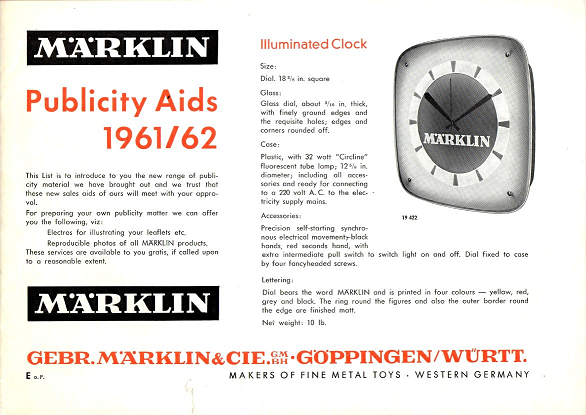
Some of the smaller catalogues were printed as a single long double-sided strip, equal to 3 x A5 pages side by side (630 x 148mm).
All items carry the usual Märklin printing code format, usually on the rear page.
The broad term “Sales Aids” includes the following themes of the topic and each to be dealt with separately.
Display and working models (Sales Models / “Verkaufsmodelle”)
Advertising and promotional items. (Publicity Aids / “Werbehilfen”)
Working and demonstration layouts. (“Schaufensteranlagen”) – usually fully automated and complete with scenery, accessories etc. These are otherwise often referred to as Shop Window or Factory Layouts. (Werksanlage)
Display, and Working models.
From the earliest days some of the most endearing items have been in the form of various working models and are found in the special (non-public) catalogues from before the 1930’s. Looking for example at the 1931 0431 catalogue “Märklin-MODELLE für Ausstellungszwecke, Schaufensterauslagen usw” (Märklin Models for exhibition purposes, shop window displays, etc.), this catalogue contains almost 40 different models, all built using components from Märklin-Metallbaukasten, (a legacy from pre-WWI association with Meccano).
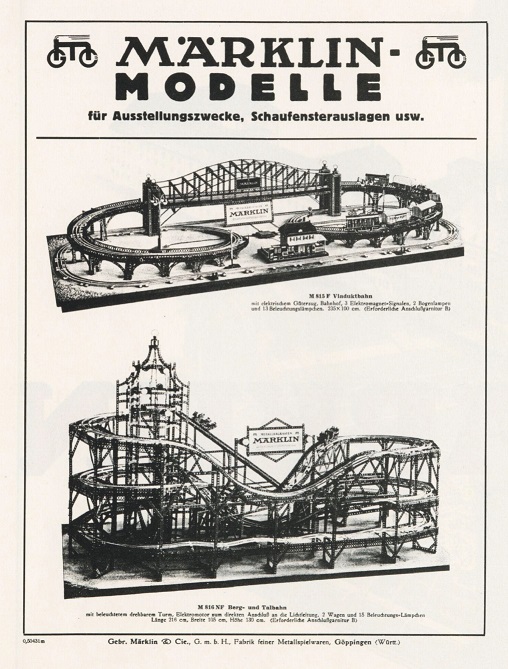
Many of the models are fully automated pieces designed for exhibitions, or to be displayed in the store, or shop window to attract attention. Often they are lighted and continuous movement is definitely a theme. Some of the models are further enhanced with the addition of Trains (0-gauge) or Automobiles for added effect. (see related article https://marklinstop.com/2011/11/marklin-miniatur-autos-and-the-rennbahn-of-the-1930s/)
It was intended by Märklin that the dealer would display the model for period of time, perhaps across a season or two, and then dismantle the item to sell off the parts and recover the initial investment. The items were often heavily discounted for the dealer and some items were even available to be rented and then credited back a portion of the original price when returned. Naturally Märklin would have preferred to sell the models outright but not all retailers could afford this outlay nor would many have the available space in their store for an extended display period.
While it is beyond the intended scope of this initial article to cover the individual models in detail (that would be a study in itself), there are some interesting aspects.
Through the 1930’s, some of the models appear only once, others remained for several seasons. The items often reflected real-life examples, including for example Cranes, Windmills, children’s See-saws & Swings, an Elevator, Boats, Planes, Automobiles of many types and on it goes. Models featuring colourful rolling balls (“Ballturm”) remained a common and popular theme, and many of these models were physically quite large. For those displays featuring trains, they tended to be either a “roller-coaster” style, or climbing up and down through a tower spiral.
During the 1930’s, some years also had an additional “Sonderliste” (special list) catalogue. The Sonderliste catalogue carried earlier models that Märklin had discontinued and were further discounted. The models in the Sonderliste catalogue were not listed in the primary catalogue.
In this example below from 1937 we see the impressive Steam Loco and Bridge stamped “Ausverkauft” (sold out).
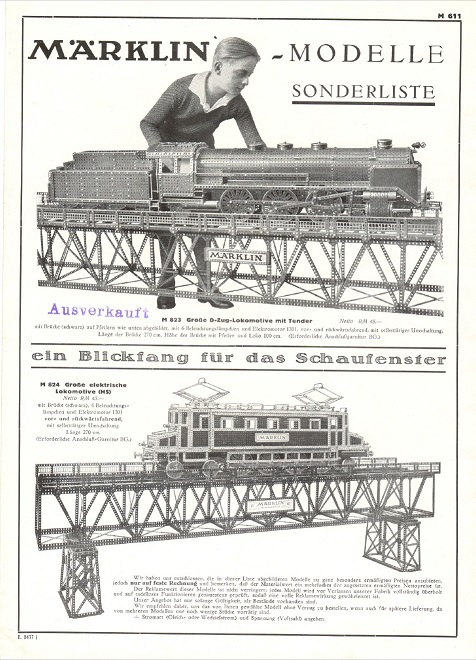
An early publication shown here is from 1928 titled “Marklin-Modelle”. The overall design and layout of this page would be repeated in similar fashion in the subsequent catalogues through to the end of the 1930’s
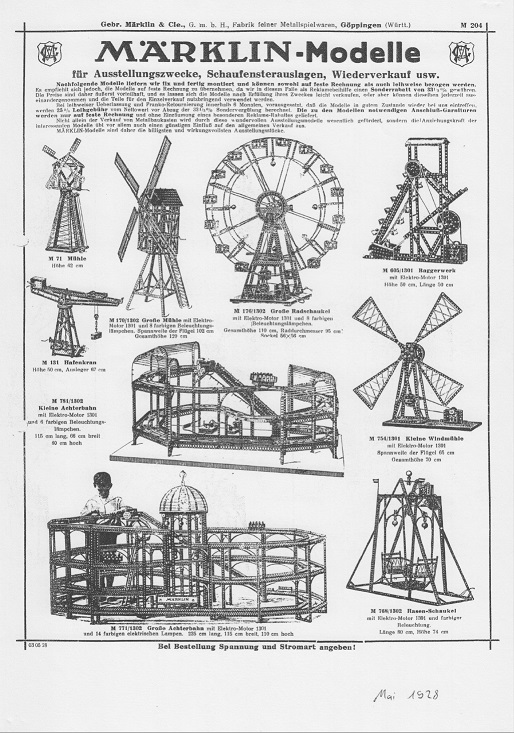
Following the war, a new but reduced range of working models appeared, and continued to be built using many components of the Märklin Metall construction range. Popular favourites such as Cranes and Windmills remained, as well as continuing the theme of a working railway in the format of a spiral / helix. Also introduced were two impressive and functional Clocks.
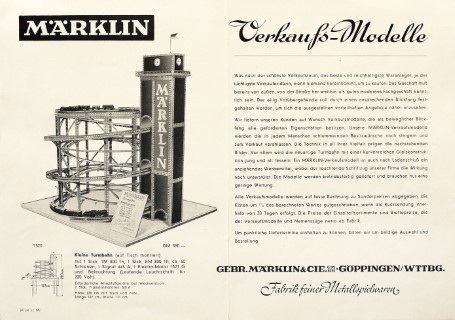
Advertising and promotional items (Publicity Aids / ‘Werbehilfen’)
Under this category are found ‘static’ items available to the dealer to promote and support their Märklin sales activity. Typically these would include such items as large display Posters for the wall or window. Also available were smaller incidental signs, such as the familiar “Märklin” logo to be displayed on a shelf or in a cabinet.
Also included in this category was an attractive wooden 4-drawer cabinet to hold spare components of the Metallbauksten range.
Advertising signage also started to appear from the early 1950’s, initially a lighted indoor sign, to be followed by larger and robust outdoor versions. Plastics also started to be used more often.

During the 1950’s in particular an item could be found one year in the Publicity aids catalogue, but in the following year would be found in the Sales Model catalogue. A good and well-known example of this is the impressive “Wonderwheel” (Wunderrad). In 1954 & ’55 it appears in the Publicity aids catalogue, but from 1956 to 1958 it is found in the Sales models catalogue. Perhaps Märklin herself was having trouble deciding exactly what category some of these models belonged to? The author does not have every catalogue for this period so more clues may yet be revealed as further information becomes available.
The Jubilee year of 1959 saw many new items added to the range of Publicity Aids. Illuminated signs, a lighted Clock and Display stands for various models among other items. Many of these items continued on through subsequent years but with regular design changes to keep them looking fresh. Some of these items also survive to this day and have become highly sought-after among enthusiasts. Especially for the more fragile items containing plastic or glass which require careful handling and are easily damaged.
The Publicity Aids catalogues have the highest number of pages, ranging from 10 – 20 pages per year.
More on these items to come in a further article.
Working and demonstration layouts (Shop window layouts / Schaufensteranlagen)
In the 1959 “Verkaufsmodelle” catalogue we find further overlap now with three factory layouts shown. One has basic scenery on a single level. A further layout is a more detailed model featuring reversing loops and a mountain terrain. Finally there is a ‘Technical’ layout, this one with no scenery but featuring an impressive range of the available working accessories. Signals, a Turntable, Crane etc. No scenery makes these accessories stand out.
The catalogue titles went through further changes during the early-mid 60’s as did the layouts themselves with the same layout rarely appearing two years running.
The factory layouts gradually took over from the Sales Models and the last catalogue for those was in the mid 1960’s. From that point, just two distinct catalogues continued, namely the Factory Layouts and the Publicity Aids.
Languages and Logistics
If the range of catalogues alone wasn’t enough, there was also the added overhead of several languages. Apart from the native German, there were also Dutch, French, Italian, Spanish, Swedish and English editions. Looking back we might wonder why they did not rationalise this sooner but of course it was a different time. Print was king, the technology we now take for granted would then have been unimaginable and there was an entire industry of multiple players built around just the publication alone of Märklin literature in its many forms.
Eventually these catalogues listed above merged into a consolidated item not only for the range of products but also the languages. 1977 & 78 saw the two former catalogues combined into a single document, “Verkaufsförderung” or “Sales Promotion” but still in a single language.
From 1979 all the remaining languages were integrated into a single stapled catalogue and in 1982 this was replaced with a ring-binder into which updates were expected to be placed as and when Märklin released them.
The final year any updates were printed is unknown at this stage.
Here we see the cover of the 1979 edition, featuring German, English, French, Spanish, Italian, Swedish, Danish and Dutch

Disclaimer – this article is based on the information currently available from various sources. There are known gaps and possibly some overlap of information.
If any reader has any examples of these catalogues and in any language, the author would be delighted to hear from you.
Also welcome are any corrections, references or additional related information.
It is certainly true as the saying goes “You don’t know what you don’t know’. At times it seemed just as one piece of the puzzle was found, another dropped onto the carpet. There is much more information yet to be found and all assistance to date has been very much appreciated.
The author reached out to many people during this research, and many have been extremely helpful with both time and information. I will acknowledge all assistance wherever possible.
These particular catalogues and leaflets can be a challenge to find but they are out there. A big issue is that it is simply impossible to monitor every possible auction or trading site all the time so I am hugely grateful to those who assist me either with their own examples, or tips on any that have become available.

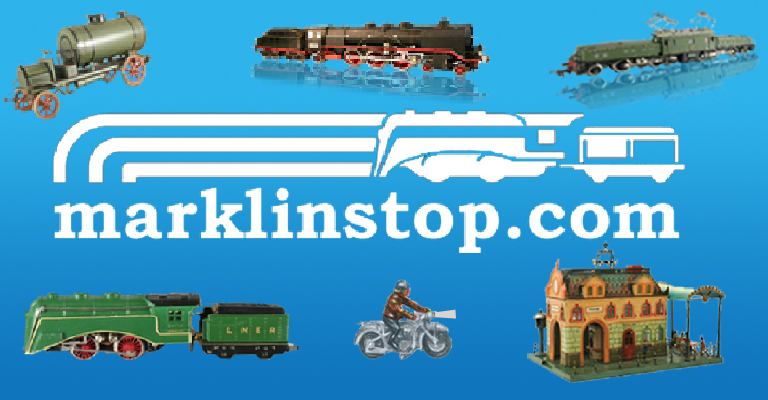
Marvelous article Stephen!
Thanks Leon, your assistance was a huge help with this article. More to come…. 🙂
Well done SC. Don’t know when you find the time.
Hi Peter, thanks for the feedback. It’s how I relax, and we all have to do that. But it often comes at the expense of something else, such as the gardening, tidying the garage etc etc
Thank you for the article, Stephen. I’ve been on a protracted hunt for a lit bar Märklin marquee.
Thanks Chris, well “all things come to those who wait”, as the saying goes. When I found my first interest in this unusual side of Märklin many years ago, I could not have imagined where it would lead. But asking around, and of course keeping an eye on auction sites certainly helped. A big issue though is geographic. Some things are just too big to ship economically, and always the risk of damage.
“Cookie” – Thanks for the Promotion items overview. Very interesting sample of non-railroad items from mother M.
Von dem Prospekt Verkaufsförderung 1979 gibt es nicht nur die hier abgebildete internationale Ausgabe (die ich zum ersten Mal sehe), sondern auch eine mit Aufdruck D DM. Ich habe davon ein paar Scans oder Fotos, woran ich aber keine Rechte habe, die also nicht veröffentlicht werden dürfen.
Joachim Saam. That is correct:
Märklin Verkaufsförderung 1979 D DM – 179 01 – MA 02 79 ru
Märklin Verkaufsförderung 1979 A o.P. – 179 00 – Yt 02 79 ru